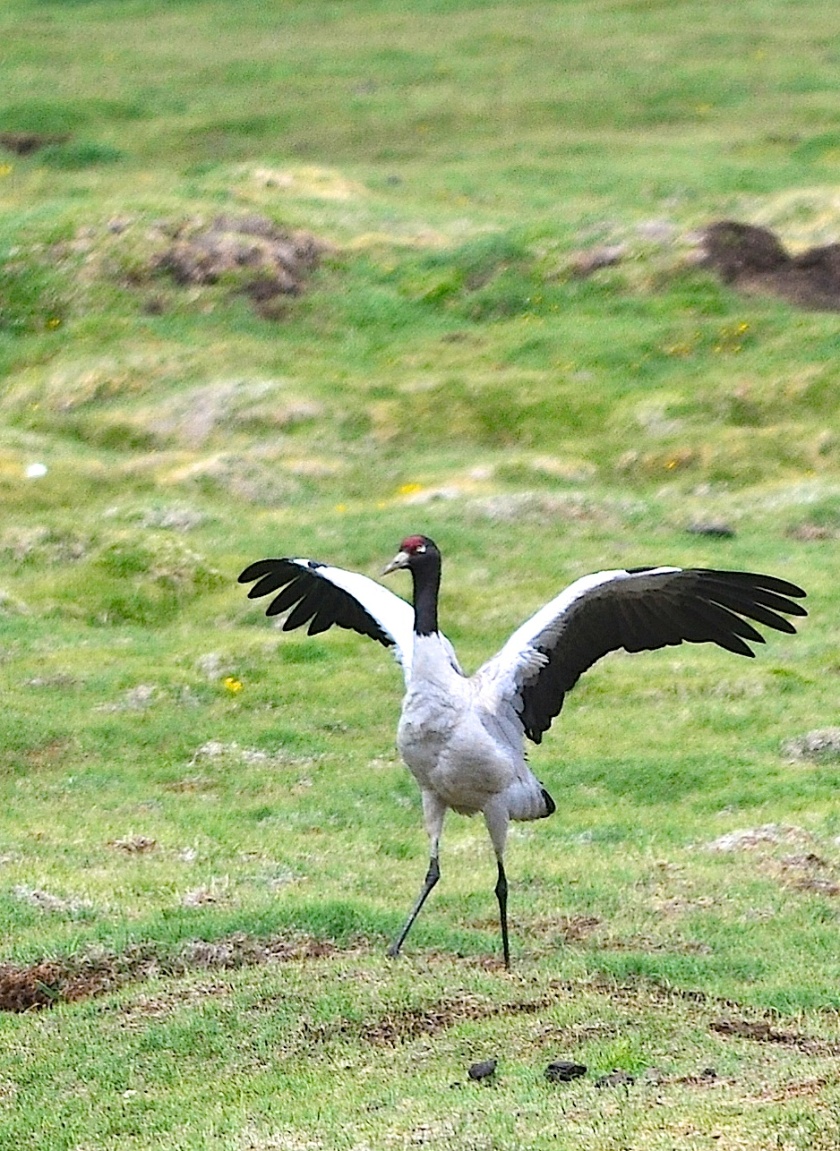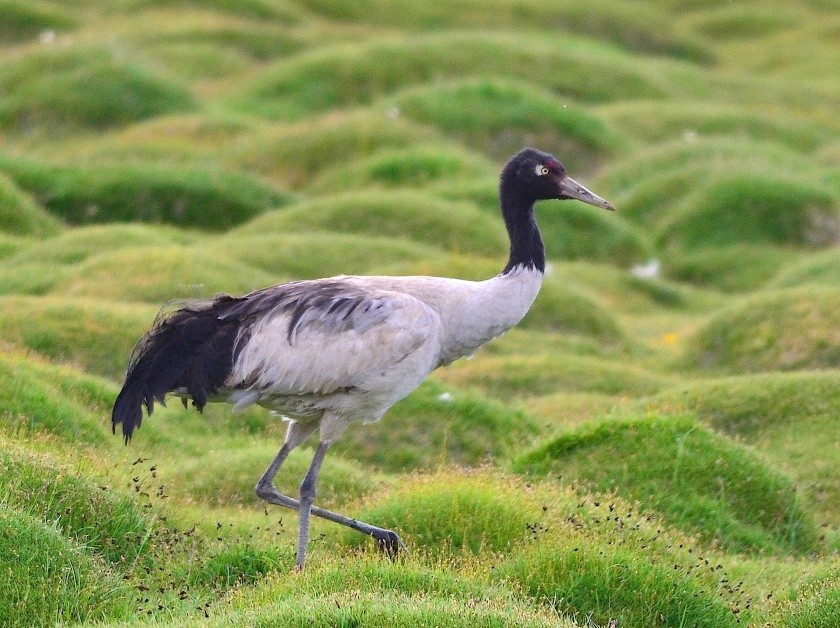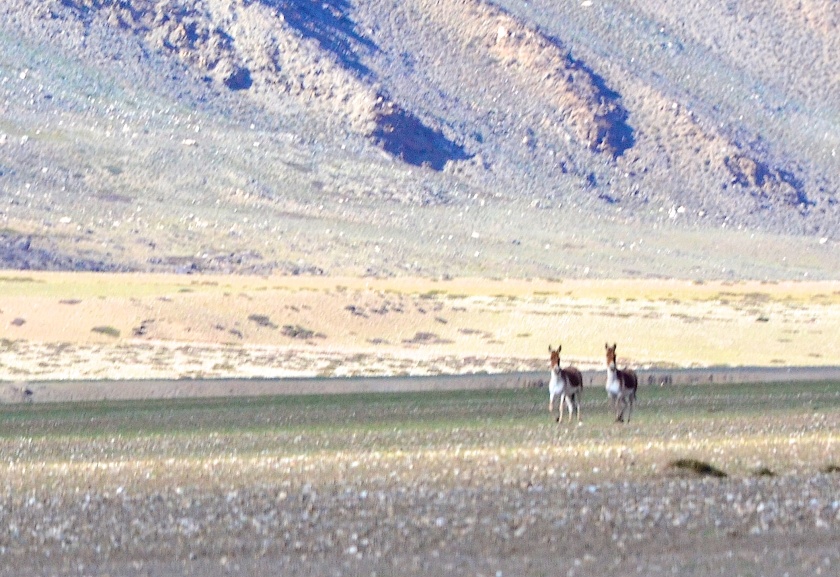We continue our journey through Ladakh and visit the third and final Lake we visited in Ladakh, Tso Kar. While Pangong and Moriri lakes are known for their sheer scenic beauty, Tso Kar is more known for the bird life and as a region where the elusive and endangered Ladakhi Wild Ass or the Kiang is seen more frequently. For birding enthusiasts, it is the only place in India where the endangered black necked cranes breed. Being a wildlife enthusiast Tso Kar was a must go place for me in Ladakh.
The drive from Tso Moriri to Tso Kar is a relatively short one (3-4 hours) and passes through the Puga valley which is known for its birds and herds of Kiang. We kept our eyes peeled and saw the Kiang at regular intervals but a long way off from the road and out of range of my 300mm to get good photos. At one such unscheduled stop looking at herds of Kiang, the better half who is a great wildlife spotter, spotted a horned lark with its lunch. My 300mm got a great photo for keeps!!

As we proceeded towards the hotel booked at Tso Kar, the misnamed Tso Kar Resort ( I don’t know the reason for the obsession of naming all hotels as resorts in India!), we saw the lake come into view. Tso Kar as compared to the other two lakes is very small and has huge natural salt pans surrounding it. The salt and the abundant food is the reason the birds like this place. Even though it doesn’t have the ocean like size of the Pangong or the desolate beauty of the Tso Moriri, Tso Kar with its salt lined banks and mountainous back drop has its own beauty. We stopped for a quick photo of the lake and the salt pans and proceeded towards the hotel.

It was almost lunch time and stomachs were growling. But that had to wait as we saw a small family of Kiang standing very close to the road, as if waiting to be photographed. I needed no further invitation and gleefully obliged. They posed patiently for me for a few minutes and then jogged off into the mountains. But that was enough for me to get some good photos of this beautiful, graceful creature. The wild ass in Ladakh has a denser coat and a bushier tail than its cousin at the Rann of Kutch ( See previous post on the Rann for photos.) and looks more a pony than an ass.

I had a big smile on my face thanks to the Kiang family as we entered the hotel. The Tsokar resort is a series of rooms facing the plains and the lake ( though it is a fair distance away). Unlike the other two lake hotels this was a recently constructed permanent concrete structure and not a tent. The rooms are basic and have a self contained bathroom. The kitchen and dining area is just opposite the row of rooms and serves hot , fresh food which as I keep on repeating is a great luxury, knowing where you are. We freshened up and had lunch and decided to wander about in the huge rocky plain behind the hotel. After a leisurely walk and taking photos of the birds and insects on view we returned to our room.

We took our camera gear and set off for the next agenda, that is to find the black necked cranes. We went to the other side of the Lake on the advice of a birding group who was also at the lodge with us. As we travelled around the lake we saw and photographed gulls, red billed chough, mountain larks, plovers, brahminy shelduck, but there were no black necked crane to be seen. But we did see a long Kiang very close and got great photos of it galloping full steam besides our vehicle.


We moved further and passed a group of trekkers who were passing through the region and saw a group of tents in the middle of a pasture. Just behind the tents I could see something that looked like a crane. By now I was seeing them everywhere like a mirage!! But this time they were there for real. A breeding pair walking about nonchalantly searching for food. Without losing any time I took photos and got some pretty decent ones. We watched the pair walk about for an hour or so till they disappeared behind a hillock.

Once I was satisfied I took photos of the far end of the lake which has a grassy bank as compared to the salt and mud of the other end. It is a wonderful contrast as the photo shows and looks more like a lake than a swamp. We walked the banks , took in the scenery and just stood around admiring what we saw.

As we returned satisfied with what we had seen, we got more!! Our driver Ali spotted a crane pretty close and we descended from the main road through the minuscule village towards the place where he had seen it. We stopped the vehicle at a distance and slowly ventured forward on foot in the fading light to get close to the beautiful bird. It didn’t rush off but kept a safe zone between us and itself and I got some good photos.

We returned to the hotel and sat outside watching the sky change colour at sun down. The depth of the colours seen in the sky in Ladakh is an experience in itself. After it became dark we had our dinner early and slept peacefully with no animals to wake us up here.

The next day was our last in the high altitude paradise of Ladakh. We were really satisfied with our experiences in the region and it brings a smile to my face as I recollect the memories for writing this post more than a year after we went. We passed through the second highest mountain pass in the world, the Taglang La Pass on to the city of Leh( The highest pass – Khardung La and the Nubra Valley is topic for another post)

I have very fond memories of these lakes of Ladakh and hope to visit them again some day. Hope you liked them and hope it inspires you to visit them to witness their magnificence in person.
Till next time. Bye..


great post,lovely pics.
LikeLiked by 1 person
Such good wildlife photos too
LikeLike
I like wildlife photography more than landscape..birds specifically..
LikeLiked by 1 person
I just love your photography and blogs … amazing …..
you are so consistent with your trips . I know Corona is like Kala Pani for you…
LikeLiked by 1 person
Thanks for reading and the appreciation sir..
LikeLike